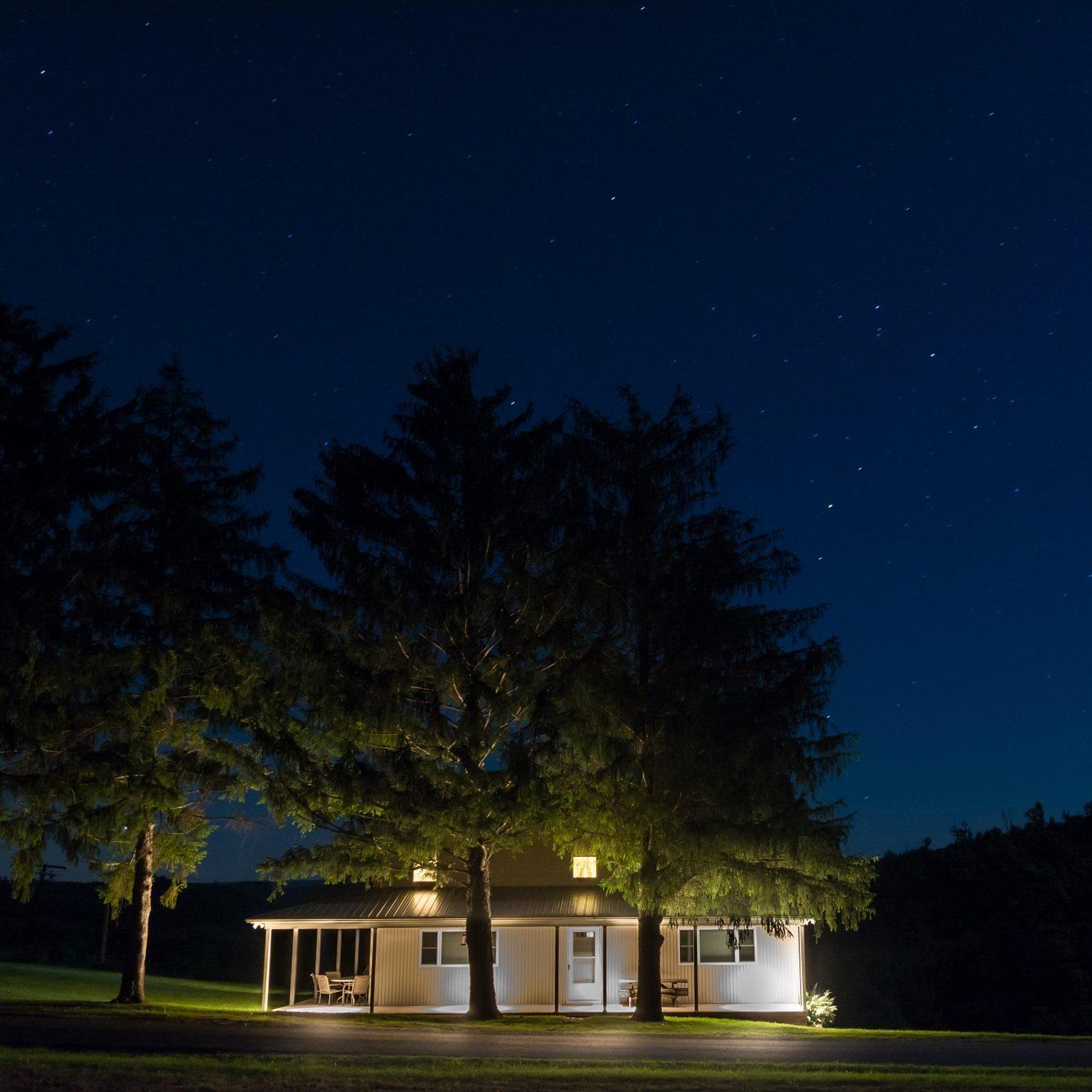ByA Serge Bielanko
Cherry Springs this and Cherry Springs that. Sometimes I get a little miffed at hearing people go on and on aboutA Cherry Springs State Park. I mean, sure, I get it. The smallish Potter County park is world famous, often listed as one of the top 5 best spots to observe the night sky on the entire planet. That’s remarkable for Pennsylvania. But at the same time I kind of look at Cherry Springs as the chisel-jawed high school football quarterback of the Pennsylvania Night Sky World, the Homecoming King that everyone wants to cuddle up to or party with.
Ugh.A
So I’m showing up here now to put an end to the nonsense. Look, knock yourself out. Go to Cherry Springs, if you can even get in. Bookings are tough, reservations are required and half the world is trying to get them. But in the meantime, guess what? There are still a lot of dark firmaments right around Bellefonte. The only catch is: can you leave the street lamps behind? Abandon your cell phone signal for a couple of hours? Are you down with packing some cold tacos and maybe a flask (shhhh!) and going out to where the bobcats roam in hopes of having a celestial epiphany?A
If that sounds like a nightmare to you, then scram. We are done here. But if you are intrigued by the notion then by all means: read on.A
Because I’m about to gift you the galaxy, my friend.A
Where to begin then?
I know.A
Let’s start with a fun fact that blew my mind this morning. A 2008 Centre County Land Use studyA found that 74% of this county is forests. And that 15% of the land is agricultural. Which means that 89% of Centre County, Pennsylvania is basically uncovered, relatively unspoiled Earth. 89% percent! Holy ****.A That is exceptional. Take it from a dude who grew up in the Philly suburbs: this Happy Valley place? It’s basically a wilderness surrounding a little football stadium and a couple of Walmarts.A
As for how much of that land is good for locating the darkest skies possible, I don’t really know the answer to that, but let’s be frank here. At the edges of Bellefonte sit a paradise of public-access wildland. Factor in all of the thousands and thousands of acres of State Game Lands, State Forests, and State Park acreage just waiting for us and we are looking at a gargantuan amount of public land. Much of it is accessible at night and far from light pollution, too.A
Yet not very far at all from your Netflix-y couch-potato self, right?A
So here we go, my humble field guide for anyone who wants to check out outer space AND never be more than, like, 20 minutes from an OIP.A
Bellefonte.com’s Night Sky Watcher’s Guide
1A. WHERE?
First off, pick a place where you think the night skies will be pretty dang dark. Maybe ask people on Facebook or something. Or if you can’t get someone to give up their spots, just look at maps online. Start with the Pennsylvania State Gamelands . Each tract varies in size and they are all assigned a generic boring number rather than a cool name, but whatever. Numbers 92, 103, 176, 295 are all within a short drive of downtown Bellefonte.A
Then, check out maps of the State Forests in this neck of the woods. Rothrock State Forest, Bald Eagle State Forest, and Moshannon State Forest each provide gazillions of acres of public access stretches in Centre County and beyond.A
The same goes for our amazing State Parks. Bald EagleA is the county standout as far as size and easy access goes, of course, but don’t overlook the rest. Penn Roosevelt State Park is not huge, but it makes up for that with relatively easy access and a truly remote location that almost guarantees epic night sky gazing if you give it a try. Also respect the deep darkness that cloaks both Black Moshannon State Park and Poe Valley State Park every single night of the year. Just across the county line, Huntingdon County is home to Greenwood Furnace State Park and Whipple Dam State Park, both natural gems that offer up some kind of dark night sky 365 days a year.A
If you want to camp, make sure you check the regulations beforehand. State Gamelands do not allow overnight camping. And other parks and forests have specific laws you need to know about before you just throw your tent up any old place.A
1B. WHERE? (PART II)
DO what you have to do, people! Date a local farmer. Or seduce their son or daughter! Then you could potentially have private access to some of the many sprawling uncovered fields around here that offer up insanely good darkness. Your own private star show! Your own private Milky Way!!
2. HOW?
Once you have some rough ideas about where you might like to try this whole dark sky thing out, it’s time to do some work. Here’s my simple but sage advice, do what you will with it. I advise you to have some fun before you venture out into the night forest or whatever. Do what successful hunters do, what many outdoor enthusiasts do instead of looking like a dipstick. Go scout the land. Figure out how to get to the area you are interested in and go there.A
In the DAYTIME.
This way you can get a feel for the dirt roads and deer paths and picker bushes and deep holes in the trail where you would fall into the Earth under the endless night sky and leave your partner screaming and the coyotes howling and all of that nonsense if you had just wandered off into the forest for the first time in the middle of the crazy dark. You need to locate places where you will actually be able to look up and see the sky. Don’t forget, Pennsylvania forests are often high, thick and lush. If you think it will be a piece of cake to just get out there in it and BOOM: stars galore, you’ve got another thing coming.A
Find the rarer spots. The ones that offer clearings. Power line cuts are really good open locations. Just make sure they are not posted private. Sometimes even the roads themselves might offer a place where you can park your car, let your eyes adjust to the dark, and ultimately be able to look up at a rather narrow but wide-open strip of celestial ceiling.A
Explore in the daylight where you want to be in the night. You can even do it all in one day. Go at noon, check it out, then go home and chill. Head back at dusk. Let your eyes adjust easy as night falls slow. You’ll already know the lay of the land a bit. It’s perfect.A
Afraid of losing the trail in the night? Understandable. There are all kinds of super cool handy glow-in-the-dark trail markers to help you navigate where you are headed in the night woods. Just remember that you need a flashlight to utilize them. And that will mean you have to let your eyes adjust for a spell before they will help you watch the skies. That seems like a fair trade-off if you are roaming out into a spot that is well off the road, huh?A
3. When?
The perfect time to take in the night sky? I’m not so sure there is one. According to the International Dark-Sky Association, a new moon offers up a more obvious dark than a brighter moon does, however, I also have read where many experienced night sky photographers actually love the interplay between a lit-up moon and the starry sky. So, it may be a bit of a toss-up that just comes down to what you prefer to experience.A
Winter and early spring though, they might be your seasons. As much as we all probably want to imagine making out with our spouses or partners under a canopy of shooting comets in the deep summer owl-hoot woods, that might not be the best idea. Think about it. Leaves on the trees blot out the sky almost entirely in many forests. So there is a better chance of not being able to see much when things are in bloom. Plus: bugs rule the night in the wilds. So either be prepared to fight mosquitos and gnats and ticks with the proper sprays and such or just go on out there and chance being a giant puffy human chigger bite.A
LISTEN TO ME. Just go. That’s all there is to this. Do your research, make your trek out there in the daylight, and then plan something beautiful and wonderful. Because that’s what this will probably end up being, you know? Right outside Bellefonte, there’s a darkness on the edge of town and it’s calling your name. This part of the world is a natural wonderland with so much ground you are free to explore. So get out there. Pack some snacks. Let someone know where you’ll be. Load up your trusty backpack, grab an old blanket, and just go.A
What’s the worst that could happen?
A shooting star falls on your head?
Pfff.A
Bring it.A
Serge Bielanko is a Centre County writer, husband, and dad.A
You can read more of him on Thunder Pie.A
For more information on exploring and supporting dark skies check out:
Protecting Dark Skies/ Pennsylvania Wilds
Find a Dark Sky Place A (This map shows the positions of locations designated as part of the International Dark Sky Places Program).A
NASA Blue Marble Navigator A (Satellite maps of Earth showing how bad light pollution is where you live and around the world).A



